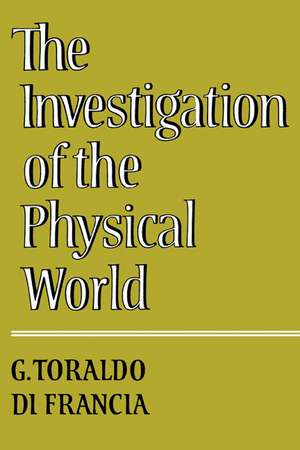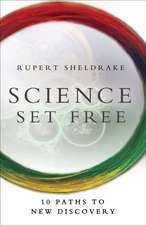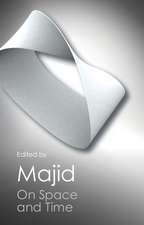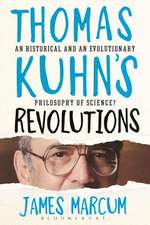The Investigation of the Physical World
Autor Giuliano Toraldo di Franciaen Limba Engleză Paperback – 28 mai 1981
Preț: 429.99 lei
Nou
Puncte Express: 645
Preț estimativ în valută:
82.28€ • 86.14$ • 68.08£
82.28€ • 86.14$ • 68.08£
Carte tipărită la comandă
Livrare economică 07-21 aprilie
Preluare comenzi: 021 569.72.76
Specificații
ISBN-13: 9780521299251
ISBN-10: 052129925X
Pagini: 480
Dimensiuni: 152 x 229 x 27 mm
Greutate: 0.7 kg
Editura: Cambridge University Press
Colecția Cambridge University Press
Locul publicării:New York, United States
ISBN-10: 052129925X
Pagini: 480
Dimensiuni: 152 x 229 x 27 mm
Greutate: 0.7 kg
Editura: Cambridge University Press
Colecția Cambridge University Press
Locul publicării:New York, United States
Cuprins
Prefaces; Part I. The Method of Physics: 1. Introduction; 2. What is physics?; 3. A first approach to the method; 4. The value of the method; 5. The operational definition; 6. The language of physics; 7. Observables or theoretical constructs?; 8. How many physical quantities are there?; 9. The precision of measurements; 10. The limits of the validity of a physical law; 11. The procedure of classical physics; 12. The mathematical functions used in physics; 13. The units of measurements; 14. The dimensions of physical quantities; 15. Theories, hypotheses, models; Part II. The Physics of the Reversible: 1. The divisions of classical physics; 2. Velocity and acceleration; 3. Curvilinear motion; 4. The laws of dynamics; 5. Work and energy; 6. The invariants; 7. Action at a distance; 8. Do magnetic charges exist?; 9. The field concept; 10. Electromagnetism; 11. Maxwell's equations; 12. The electromagnetics waves; 13. The polarization of material media; 14. Reflection, refraction, dispersion; 15. Lenses and images; 16. The physical theory of vision; 17. How do we really see?; 18. Interference and diffraction; 19. The Galilean relativity; 20. Einstein's relativity; 21. The Lorentz transformation; 22. Length contraction and time dilation; 23. The limiting velocity, the past and the future; 24. The invariance of the laws of physics; 25. Gravitation; 26. General relativity; 27. Consequences of general relativity; 28. Physical theories; 29. The richness of the man-nature relation; Part III. The Physics of the Irreversable: 1. Reversability and irreversability; 2. Temperature and heat; 3. Perfect gases; 4. Heat, work, and internal energy; 5. Specifics of a heat gas; 6. The second law of thermo dynamics; 7. The entropy; 8. The nonlinear development of classical thermodynamics; 9. The kinetic theory; 10. Probability; 11. Information; 12. Information and probability; 13. The transmission of informations; 14. Microstates and macrostates; 15. Statistical irreversability; 16. Does time have an arrow; 17. Fluctuations; Part IV. Microphysics: 1. The objects of physics; 2. Spectral lines; 3. Electrons; 4. Classical models of the atom; 5. Planck's quanta; 6. Photons; 7. The Bose–Einstein statistics; 8. Bohr's atom; 9. Waves and particles; 10. The probabalistic interpretation; 11. Spin, atoms and molecules; 12. Bosons, fermions, antimatter; 13. The uncertainty principle; 14. The Hilbert space; 15. The formalism of quantum mechanics; 16. Revision of the general scheme of physics; 17. Difficulties of quantum mechanics; 18. Microphysics and reality; 19. Determinism and indeterminism; 20. Causality; 21. The inductive inference; 22. Quantum electrodynamics; 23. The atomic nucleus; 24. The second crisis of classical physics; 25. Particles multiply; 26. Interactions and conservations; 27. Toward the grand unification; 28. Materialism and mechanism in contemporary physics; Part V. The Universe: 1. General laws and historical facts; 2. Form and movements of the earth; 3. The earth's structure; 4. The cosmogonic problem; 5. The environment and the biosphere; 6. The origin and evolution of life; 7. Windows on the universe; 8. The solar system; 9. The origin of the solar system; 10. The stars; 11. Neutron stars, pulsars, blackholes; 12. The galaxies; 13. Cosmological hypotheses; 14. Life in the universe; Notes; References; Indices.
Descriere
This book is both a high-level popularization and a critical appraisal of the methods scientists use to investigate the physical world.


















